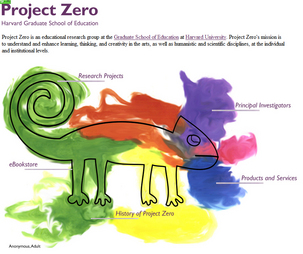Related Websites

Making Learning Visible Home Website
Making Learning Visible (MLV). MLV draws attention to the power of the group as a learning environment and documentation as a way to see and shape how and what children are learning. MLV is based on collaborative research conducted by Project Zero researchers with teachers from the Municipal Preschools of Reggio Emilia, Italy, and preschool through high school teachers and teacher educators in Massachusetts.
Making Learning Visible (MLV). MLV draws attention to the power of the group as a learning environment and documentation as a way to see and shape how and what children are learning. MLV is based on collaborative research conducted by Project Zero researchers with teachers from the Municipal Preschools of Reggio Emilia, Italy, and preschool through high school teachers and teacher educators in Massachusetts.

Project Zero Home Website
Project Zero is an educational research group at the Graduate School of Education at Harvard University. Project Zero's mission is to understand and enhance learning, thinking, and creativity in the arts, as well as humanistic and scientific disciplines, at the individual and institutional levels.
Project Zero is an educational research group at the Graduate School of Education at Harvard University. Project Zero's mission is to understand and enhance learning, thinking, and creativity in the arts, as well as humanistic and scientific disciplines, at the individual and institutional levels.

Visible Thinking Home Website
Visible Thinking is a flexible and systematic research-based approach to integrating the development of students' thinking with content learning across subject matters. An extensive and adaptable collection of practices, Visible Thinking has a double goal: on the one hand, to cultivate students' thinking skills and dispositions, and, on the other, to deepen content learning. By thinking dispositions, we mean curiosity, concern for truth and understanding, a creative mindset, not just being skilled but also alert to thinking and learning opportunities and eager to take them
Visible Thinking is a flexible and systematic research-based approach to integrating the development of students' thinking with content learning across subject matters. An extensive and adaptable collection of practices, Visible Thinking has a double goal: on the one hand, to cultivate students' thinking skills and dispositions, and, on the other, to deepen content learning. By thinking dispositions, we mean curiosity, concern for truth and understanding, a creative mindset, not just being skilled but also alert to thinking and learning opportunities and eager to take them

Reggio Children Home Page
Reggio Children's aims and purposes are inspired by the philosophy and values of the educational project developed and practiced in the Municipal Infant-toddler Centers and Preschools of Reggio Emilia, in order to protect and communicate the wealth of knowledge developed within this experience.
The aims of Reggio Children include: fyfuy to communicate a forceful idea of childhood and of children's rights, potentials, and resources, which are often unrecognized or neglected;
to promote studies, research, and experimentation in education, with particular emphasis on children's active, constructive, and creative learning processes;
to advance the professionalism and culture of teachers, promoting a greater awareness of the value of collegial work and of meaningful relationships with the children and their families;
to highlight the value of research, observation, interpretation, and documentation of children's knowledge-building and thinking processes;
to organize guided visits to educational programs, cultural initiatives, exhibitions, seminars, conferences, professional development courses on the issues of education and the culture of childhood.
Reggio Children's aims and purposes are inspired by the philosophy and values of the educational project developed and practiced in the Municipal Infant-toddler Centers and Preschools of Reggio Emilia, in order to protect and communicate the wealth of knowledge developed within this experience.
The aims of Reggio Children include: fyfuy to communicate a forceful idea of childhood and of children's rights, potentials, and resources, which are often unrecognized or neglected;
to promote studies, research, and experimentation in education, with particular emphasis on children's active, constructive, and creative learning processes;
to advance the professionalism and culture of teachers, promoting a greater awareness of the value of collegial work and of meaningful relationships with the children and their families;
to highlight the value of research, observation, interpretation, and documentation of children's knowledge-building and thinking processes;
to organize guided visits to educational programs, cultural initiatives, exhibitions, seminars, conferences, professional development courses on the issues of education and the culture of childhood.

The North American Reggio Emilia Alliance (NAREA) home website.
NAREA is a network of educators, parents, and advocates seeking to elevate both the quality of life and the quality of schools and centers for young children.
NAREA is a network of educators, parents, and advocates seeking to elevate both the quality of life and the quality of schools and centers for young children.